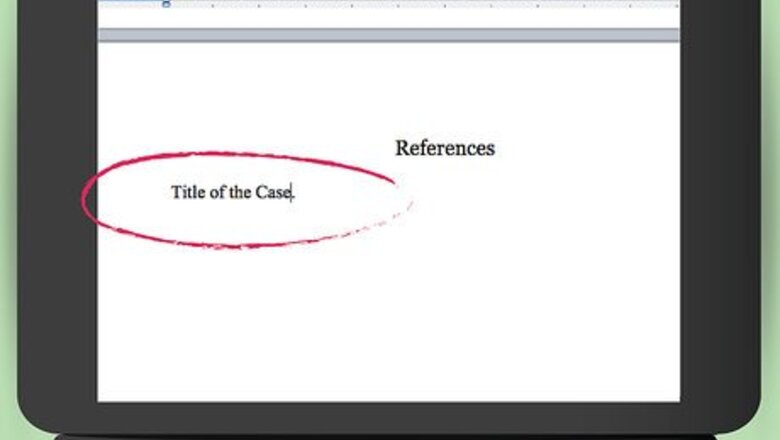
views
X
Research source
Citing Case Law
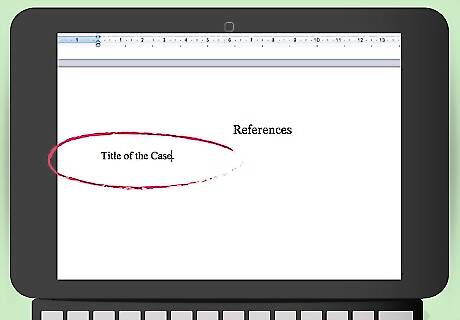
Write the name of the case. A legal citation to a court case begins with the title of the case itself, as it appears in the case reporter you're using. Generally, you should only use last names or business names. Don't include the phrase "et al." to indicate there is more than one party to the suit. Italicize the phrases "In re." or "ex rel." If the reporter says "on behalf of," or "for the use of," change that to "ex rel." If the reporter says "In the matter of" or "Petition of," use "In re." in your citation. Table 6 of the Bluebook contains abbreviations that must be used. Any words in the name of the case that are listed on that table should be abbreviated according to that table. Generally, omit the word "the" from the beginning of a case name. Abbreviate states unless they are parties. Then you must spell them out. If you're referencing a state case, just use "State" or "Commonwealth." However, if it's a federal case and the state is a party, use just the name of the state. For example, if you were citing a U.S. Supreme Court case, the name would be "Virginia v. Smith," not "The Commonwealth of Virginia v. Mary Smith." However, if the case was a Virginia Supreme Court case, the name would be "Commonwealth v. Smith." If you're citing the case within the text rather than in a footnote, the case name should be italicized. In court documents such as briefs or motions, the case name typically is underlined.
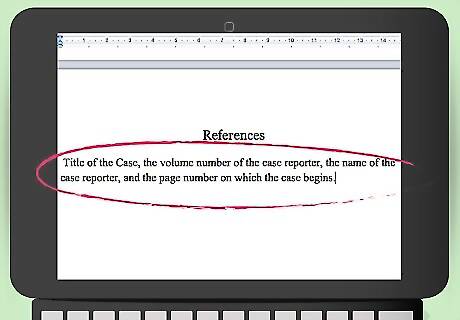
Identify where the case was published. Place a comma after the name of the case and follow it with the volume number of the case reporter, the name of the case reporter, and the page number on which the case begins. For U.S. Supreme Court opinions, you must use the U.S. reporter. The abbreviation is "U.S." with no spaces. For Federal Court of Appeals cases, use F., F.2d, or F.3d, with no spaces. Federal District Court decisions normally are cited from "F. Supp." Note that there is a space between the abbreviations. The volume number of the reporter is the first number after the comma following the case name. Then type the name of the reporter, followed by a space, followed by the page number on which the case starts. If you are citing a particular page of the case rather than the case as a whole, put a comma after the first page of the case, add a space, and then put the page number of your pinpoint cite. For example, at this point your citation might look something like this: "Virginia v. Smith, 60 F.2d 313, 327." If the material you are citing covers several pages, provide the first and last page of the excerpt with a hyphen between them: "Virginia v. Smith, 60 F.2d 313, 327-30." Note that you should only use the last two digits of the ending page if the first is identical.

Place the year the case was decided in parentheses. Follow the page numbers with a space, then put the year of the case in parentheses. The name of the court that decided the case also should be included in parentheses, if it isn't obvious from the reporter used. For example, the United States Reports only includes U.S. Supreme Court cases. So if your citation is to a Supreme Court case published in the U.S. Reports, you can just use the year, like so: "Virginia v. Smith, 24 U.S. 283, 287 (1982)." For federal Court of Appeals cases, you must provide the circuit. If you're citing a federal District Court case, identify the district. If the court is the highest court in the state, you would include the state abbreviation. Put a space after the court identification, then the year the case was decided. At this point, a federal Court of Appeals citation would look something like this: "Virginia v. Smith, 60 F.2d 313, 327 (2d Cir. 1979)."
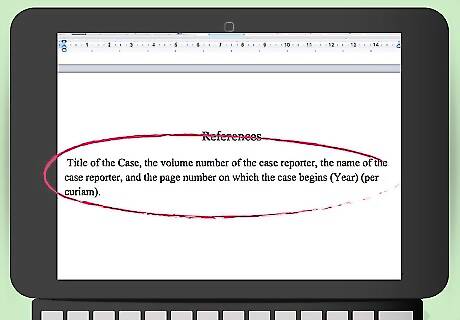
Include conditional items. If you're not citing a majority opinion, or if anything happened to the case after the decision you're citing, this should be included next, using the explanatory phrases and abbreviations included in Table 8 of the Bluebook. Descriptions having to do with the case itself are included in parentheses. For example, if the opinion had no author, you might put "(per curiam)" after the year, with a space between the parentheses, such as "Virginia v. Smith, 24 U.S. 283, 287 (1982) (per curiam). To add procedural history – that is, something that happened to the case after the opinion you're citing that may affect the authority of that particular case – put a comma after the parentheses, then a space, then write the applicable phrase. Keep in mind that the explanatory phrase should be italicized and followed by a comma. For example, suppose the federal appeals court decision you are citing was affirmed by the U.S. Supreme Court. Your citation would look like this: "Virginia v. Smith, 60 F.2d 313, 327 (2d Cir. 1979), aff'd, 24 U.S. 283 (1982)."
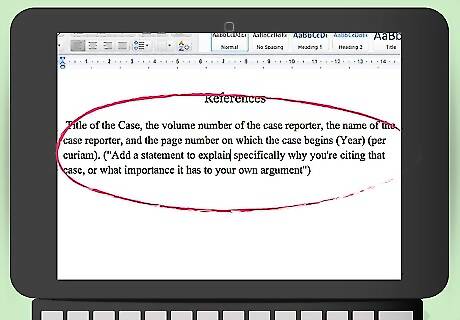
Add parenthetical information. After all of the citation information, you may feel it necessary to add some information in parentheses that explains specifically why you're citing that case, or what importance it has to your own argument. This information is never necessary, but you should consider adding it if you think it would enhance the citation for the reader. One circumstance where it arguably is necessary is if, in the portion of the case you're citing, the judge is paraphrasing or citing another case. Parenthetical information typically is a phrase beginning with a gerund, such as "(holding cupcakes are form of self-expression protected by the First Amendment)." If you're using such a phrase, there are no capitals, and the phrase is not italicized. In other instances, you may want to draw the reader's attention to a particular passage in the opinion. Put that in parentheses with quotes around it. For example, you might write "("Words written in icing are entitled to no less protection than words written in pen...")."
Citing Statutes or Regulations

Write the name of the act. The official name of a statute isn't strictly necessary, but should be included if the statute is commonly called that, or if it makes it easier for your readers to identify. If you do include the name of the act, it should be listed first in your statutory citation. If you do include the title of the law, there is no special formatting such as italics required. If the law you're referencing is spread out over several sections of the code, you should cite to the session law instead of a code section if you intend to cite the entire law. The session law is the law itself as it was enacted by the legislative body, before it was recorded into the legislative code. This situation may occur if you are referencing a law such as The Patriot Act, which amended many other laws already on the books.
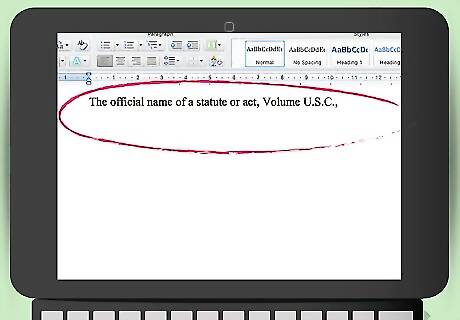
Include the volume and name of the code. A statutory code is a compilation of laws enacted by a particular legislative body, such as a state legislature or the U.S. Congress. These volumes are similar to case reporters that contain court decisions. For example, you would cite a federal law by writing "28 U.S.C.," which indicates the volume (28) of the U.S. Code (U.S.C.) where the law is located. Table 1 of the Bluebook lists the approved code compilations for state laws and their abbreviations. While there are official code compilations, there also are code compilations published by the legal publishers LexisNexis and West. If you are using one of these code compilations, this should be indicated accordingly.
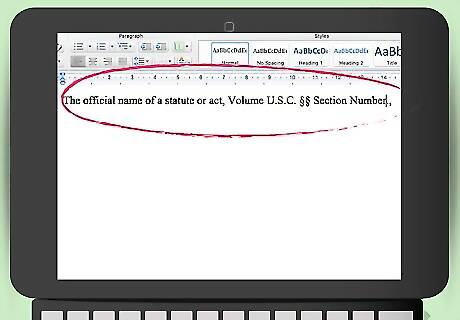
Indicate the section referenced. After you've written the name or abbreviation of the code compilation in which the statute appears, put a space and indicate the particular section with the information you're citing. Use a "§" before the number to stand for "Section." If you are referencing multiple sections, this should be indicated by "§§." If you intend to reference several sections together in a series, connect the first and last section with a hyphen. To indicate a reference to two or more separate sections, put the section numbers separated by a comma and a space. An example of multiple sections in a series would be "28 U.S.C. §§ 402-407." In contrast, multiple sections not in series would look like this: "28 U.S.C. §§ 402, 409." You also can combine the two methods, for example: "28 U.S.C. §§ 402-407, 409."
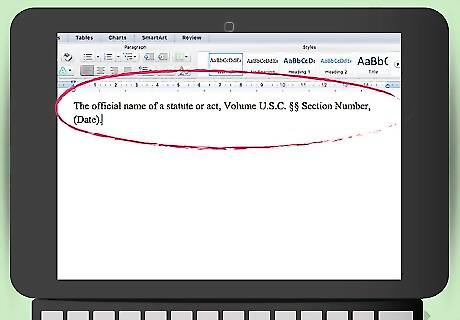
Add the date of the code. At the end of your statutory citation, put the date the code volume was published – not the date the statute itself was enacted – in parentheses. The purpose of this date is to allow your readers to find the same edition of the law that you used in your work. You can find the date you need by looking at the spine of the volume, the volume's title page, or the volume's copyright information. You should check these places for the year in that order. In other words, if the date isn't on the spine, check the title page. If you can't find the date on the title page, check the copyright information. Keep in mind that even if you're looking at a statute online, you technically should check the bound volume to find the information necessary for your citation. Compare the online text to the text in the volume to make sure you have the correct volume and the two versions are identical before citing.
Citing Books and Treatises
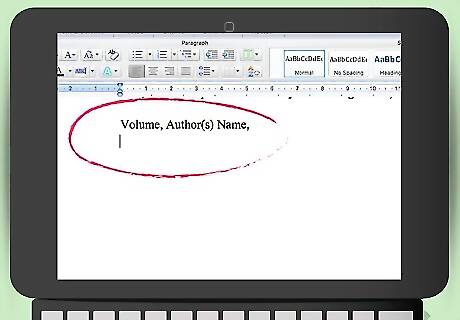
Write the volume number. Legal treatises often are multi-volume affairs, and require you to include the volume number in which the material appears that you are referencing. Regular books typically won't have this information. The volume number is not followed by any punctuation such as a period or a comma. Rather, you simply type the volume number, then a space, then begin the next part of the citation, which will be the name of the author.
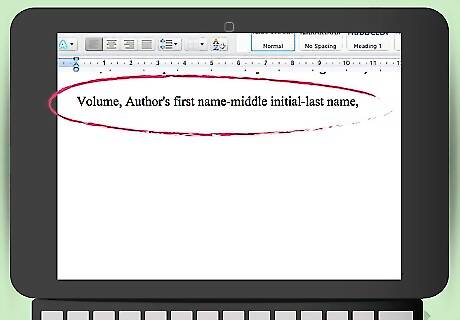
Provide the full name of the author. The Bluebook requires the author's entire name, written just as you would write it in text – first name, middle initial, last name – rather than with the last name written first as in some other citation style guides. If there is more than one author, connect their names with an ampersand. For more than two authors, you typically would only use the first author's name followed by the phrase "et al." However, include the other authors' names if they are somehow significant. For example, if you are citing a book during the course of your argument that Judge John J. Jameson, Jr. wrote extensively about cupcake decency laws and their implications on freedom of speech, you would want to include his name in your citation of a book he co-authored on the subject, even if he was the third author listed. If the author is a business or institution rather than a person, simply write the name of that entity where you would normally cite the author's name.
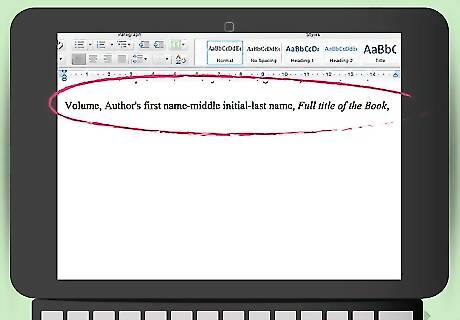
Include the full title of the book. After the name of the author, put a comma and a space and then write the full title of the book, either underlined or in italics. All words in a title other than articles, prepositions, and conjunctions should be capitalized. There is no punctuation following the title of the book.
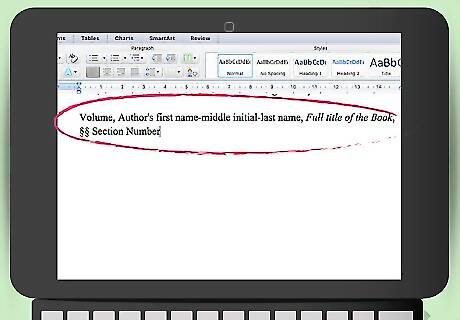
Indicate the portion of the book you are referencing. For a regular book, you typically would write the page number or numbers where the material you want to cite is located. Some legal treatises are organized in sections, so you should cite the section rather than the page number. Cite to sections using the symbol "§" for a single section or "§§" for multiple sections. If you're citing to a series of pages, the page numbers should be connected by a hyphen. If the first of three or more digits are repeating, only the last two digits are needed for the last page in the series, such as in "Cupcakes and First Amendment Freedom of Expression 290-95." If you are citing to multiple pages not in series, separate the page numbers with commas. You also can cite a series of pages and a single other page. To cite a footnote appearing on a particular page (or in a particular section), put a comma after the page (or section) number, add a space, and type "n." followed by the footnote number. There is no punctuation following the page number citations in Bluebook citation format.
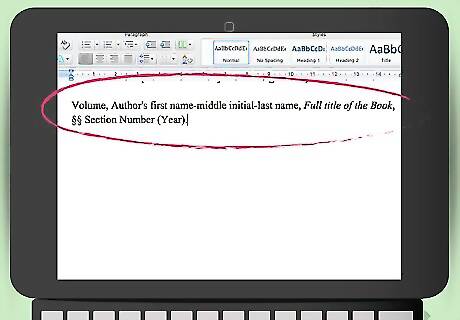
Put the edition and year of publication in parentheses. If there are multiple editions of the book, you must indicate the one you used. If there's just one edition of the book, all you need is the year in which it was published. The year of publication typically can be found either on the book's title page or within the book's copyright information. A full citation of a book might look something like this example: John J. Jameson, Jr. Cupcakes and First Amendment Freedom of Expression 290-95 (2005).
Citing Articles from Periodicals
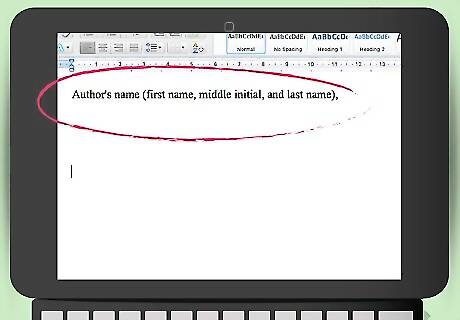
Write the full name of the author. A citation to a periodical article, whether in a law journal, magazine, or some other publication, starts with the full name of the author, written in order of his or her first name, middle initial, and last name. Include any suffixes, such as "Jr." However, omit any initials or titles used to indicate degrees or affiliations, such as "Dr." or "Ph.D." If there are two authors, list them in the order listed on the article, connected by an ampersand. If there are more than two authors, you can cite them using the name of the first author followed by "et al." You also can list all authors if you choose to do so, or if the names of all authors carry some significance. Institutional authors should be listed using the same rules, such as if the article has a company or educational institution listed as the author rather than an individual person. Do not reduce middle names to middle initials unless that is how they appear in the article itself.
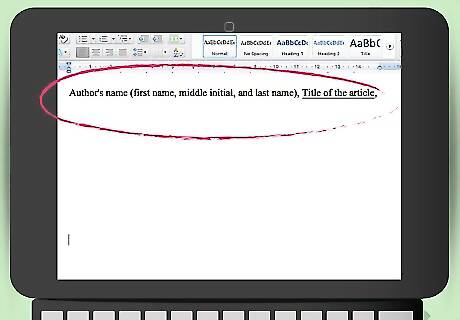
Provide the title of the article. After the author's name, put a comma and a space and then write the full title of the article you wish to cite. The article's title typically is underlined in court documents such as briefs or motions. All words should be capitalized, except articles, conjunctions, or prepositions, unless these are the first word in the title or the first word that follows a colon. Do not omit words or abbreviate any words in the title.
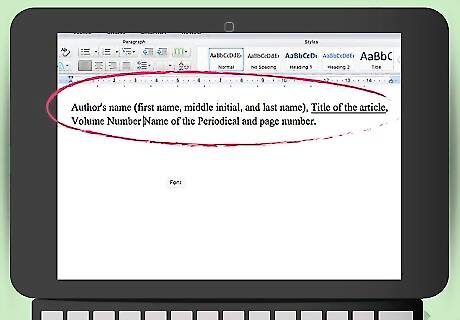
List the name of the periodical and the page number on which the article appears. How you format the name of the periodical depends to some extent on what sort of periodical it is. Law journals typically begin with a volume number, then the name of the journal, then the first page on which the article appears. If the periodical is a law review or journal, its name should be abbreviated using the rules in Table 13 of the Bluebook. How you format the page number depends on the way the periodical itself is paginated. Many law journals use consecutive pagination – while there may be four issues of a single volume, the volume starts with page one in the first issue and the pages continue in order for each issue. In other words, the journal doesn't start over with page one at the beginning of each issue, as most magazines and other periodicals do. If the periodical uses consecutive pagination, you simply follow the name of the periodical with the page number, as in "12 Case W. L. Rev. 392." For periodicals that do not use consecutive pagination, but instead start page numbers over with each issue, the page number on which the article appears should follow the date of the periodical and be preceded by the word "at," as in "National Geographic, Mar. 2005, at 17."

Include the year or date of publication. The next portion of a periodical citation is the date of publication, although the format differs depending on whether the publication uses consecutive pagination. For periodicals that use consecutive pagination, you will place the year of publication in parentheses immediately following the page numbers. If you're citing a periodical, such as a magazine, without consecutive pagination, the date of the issue should be included between commas before the page number. The citation for periodicals with consecutive pagination looks like, and follows many of the same rules, as a citation to a judicial opinion. You start with the volume number, then the name of the journal, then the page number where the article starts. If you're providing a pinpoint citation to a particular page, add a comma and a space and then follow with that information.
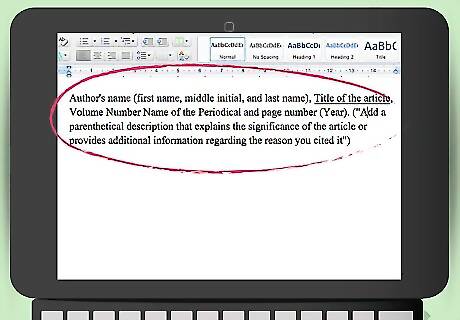
Add descriptive information if necessary. If you want to add a parenthetical description that explains the significance of the article or provides additional information regarding the reason you cited it, you can include this information in parentheses following the citation itself. As with a citation to a judicial opinion, you can add parenthetical information that assists your reader in understanding why you cited a particular article, or what relationship it has to your text. These descriptions typically are written as phrases beginning with a gerund such as "stating" or "arguing." You also can provide a brief quote or beginning of a quote from the text, particularly if you want to point your reader to specific language in the article.












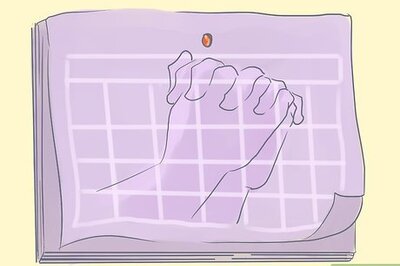






Comments
0 comment